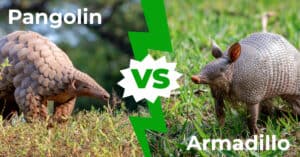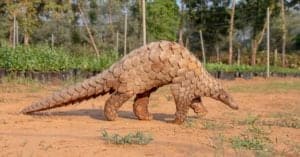Covering the pangolin’s body are rows of overlapping scales with an uncanny resemblance to artichoke leaves. When threatened, pangolins deploy the defense of rolling into a ball. This has earned them their name, which comes from the Malay word pengguling. This word means “something that rolls up.” Their scales act as protective armor to shield them from imminent threats.
Pangolins live throughout Asia and Africa. Some call them “scaly anteaters.” However, despite their shared diet, they’re distantly related to anteaters. An interesting feature of these creatures is their complete lack of teeth. Pangolins have a number of adaptations suited to their specialized diet in place of the teeth that most mammals possess. So, what do pangolins eat?
What Do Pangolins Eat?
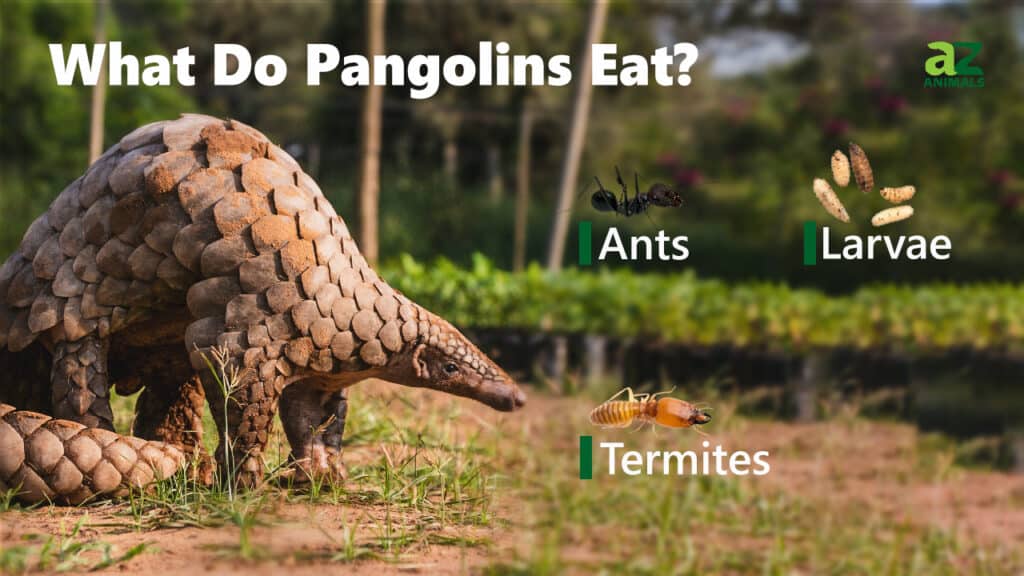
Pangolins eat a diet that consists of various species of ants, termites, and insect larvae. They are carnivorous insectivores.
Ants and termites are suitable prey as they have centralized nest structures and large populations. Pangolins find these tiny prey through scent-based foraging. Insect larvae are also an important source of nutrition, especially for arboreal pangolin species.
Below is a list of foods pangolins eat:
- Ants
- Termites
- Larvae
Where Do Pangolins Find Food?
There are eight species of pangolins, four are African pangolins, and four are Asian pangolins. Some species are arboreal, dwelling in trees and seeking food and shelter within their branches. Others are terrestrial, living in subterranean burrows and remaining close to the earth. However, all species can navigate across water when they need to. They live anywhere there is an abundant population of ants and termites and are generally found near water sources. Tropical forests, thick brushes, cleared areas, cultivated areas, and grasslands are suitable habitats.
How Do Pangolins Find Food?
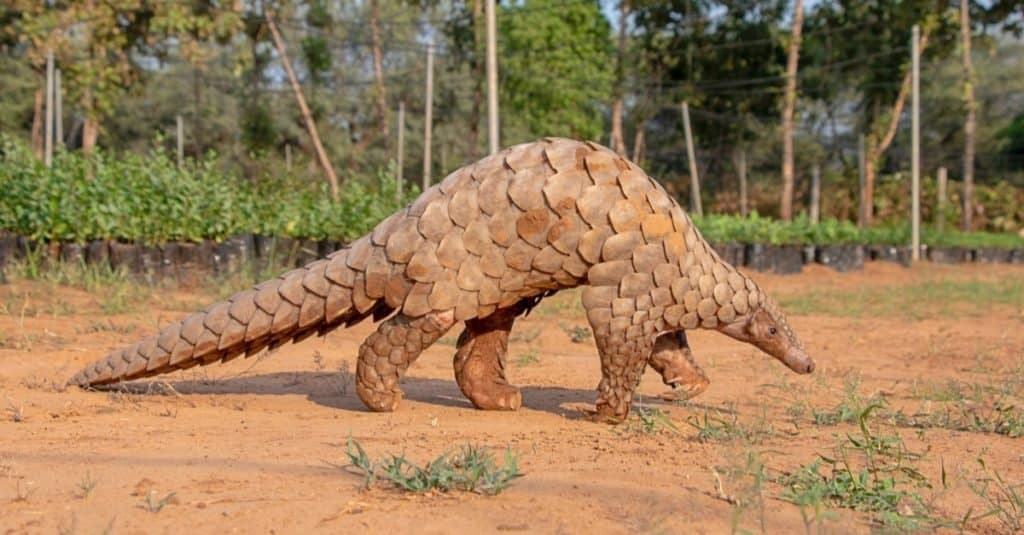
Pangolins have an incredible sense of smell to seek out hives and nests.
©Vickey Chauhan/Shutterstock.com
As nocturnal animals, pangolins rely on their senses of hearing and smell to hunt in the dark of night. While they lack strong vision, pangolins have an incredible sense of smell. This allows them to seek out hives and nests and pinpoint small insects’ locations beneath the soil or under tree barks. Once identified in mounds, stumps, tree limbs, and fallen logs, pangolins capture and consume their prey. Pangolins generally live in hollow trees or burrows. They’ll sometimes dig their burrows near termite mounds and anthills in order to have a consistent supply of food.
How Do Pangolins Eat?
Pangolins possess an assortment of adaptations for eating insects. Firstly, they’ve got long and flexible tongues that can extend far into cavities to reach the insects. It’s coated with sticky saliva suited to capturing them and keeping them in their mouth. Secondly, pangolins possess a gizzard-like stomach that assists them in processing the tough material of insects’ bodies. Their stomachs are muscular with keratinous projections that extend internally. To aid in the digestive process, they’ll ingest small stones and bits of sand. Thirdly, they have forelimbs that end in sharp claws, well adapted to breaking open hives and nests. In addition, scales adapt to eating insects because they prevent them from irritating their skin. Finally, they’ve got special muscles to seal their nostrils shut and protect them from sand and dust as they eat.
How Do Pangolins Affect the Ecosystem?
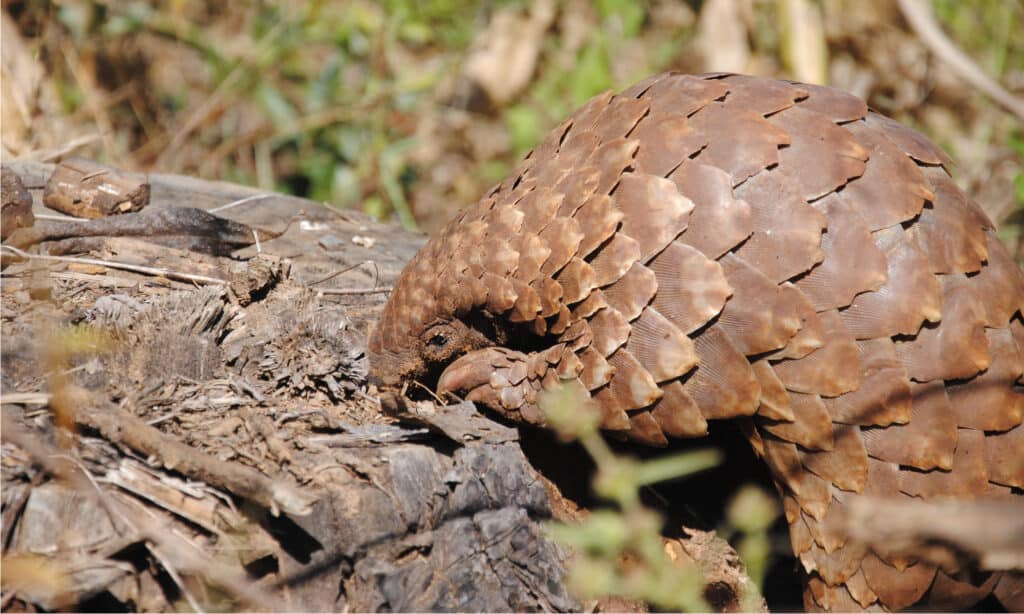
Pangolins affect the ecosystem by contributing to the regulation of the insect population.
©Gemma Campling/Shutterstock.com
According to an article in ScienceDirect, pangolins perform an important ecosystem service by contributing to the regulation of insect populations. It’s estimated that one adult pangolin can eat around 70 million insects a year.
Pangolins likely affect soil processes as they excavate burrows and dig through the earth. Their role performs the service of turning over organic matter and providing aeration. They may act as bioturbators, modifying ecosystem characteristics by reworking the soils. An article in Mammal Review states that soil bioturbation can improve ecosystem health by reducing soil compaction, increasing nutrient cycling, soil moisture, microbe diversity, plant recruitment, and carbon storage. The loss of mammals that engage in bioturbation could trigger cascading effects throughout their ecosystems.
Threats to Pangolins
Humans poach pangolins for both their keratin-based scales and for meat, and they are also the most illegally trafficked animals in the world. People use their distinctive scales for medicine and ritual decoration in several traditions. In some countries, pangolin meat is considered a delicacy.
Humans are the most significant threat of pangolins, and all eight species face some risk of extinction. Natural predators within their range include lions, hyenas, leopards, and pythons. The pangolins’ main defense is rolling into a ball, and their armor-like scales can cut through muscle action, sometimes inflicting serious wounds. These tough, termite-loving, eccentric creatures can also emit a noxious-smelling acid from their glands, similar to skunks, to mark their territory and deter danger.
The photo featured at the top of this post is © 2630ben/Shutterstock.com
Thank you for reading! Have some feedback for us? Contact the AZ Animals editorial team.



